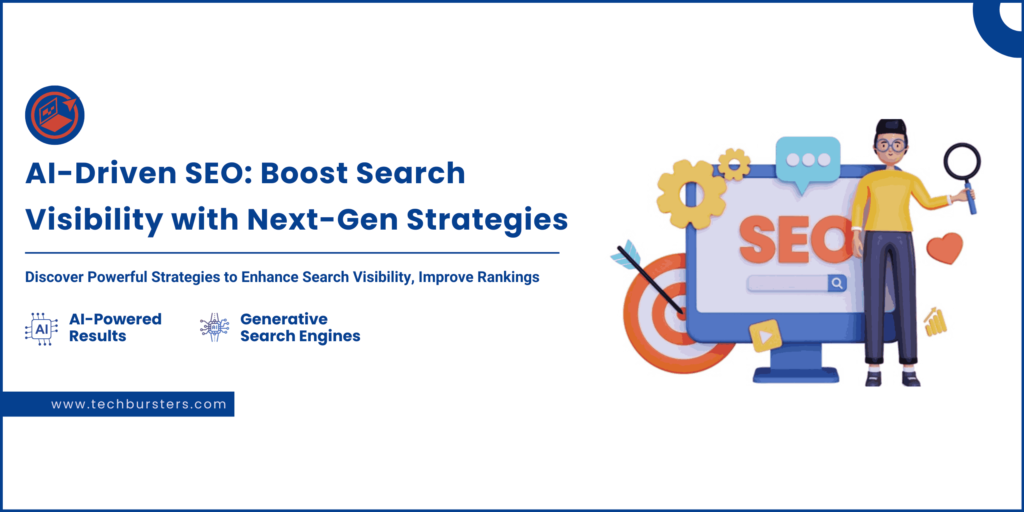
As long as we have had search engines available to us, the rules of visibility have been relatively predictable. If you publish good content, use the right keywords, and build authority through the use of links, your site could rise through the rankings.
But this is changing. Artificial intelligence is not just evolving algorithms; it is completely changing the way information is found, delivered to users, and consumed by people.
Tools like Google Search Generative Experience, Bing, and AI chatbots such as ChatGPT are changing what it means to be search-visible online. Rather than competing for a spot on the page of links, brands now face a set of entirely new challenges: being included in AI-driven answers that may appear before a user even considers clicking on something.
The implications of this are massive for businesses. Traditional SEO cannot guarantee visibility anymore, and it is something that you need to concentrate on in order to succeed.
Businesses need to start looking at this in a different way. They need to start using human storytelling with machine understanding. This is precisely where AI-driven SEO comes in.
Let’s have a look at this more below:
Why Traditional SEO Is No Longer Enough
Searching online used to operate in a really linear way. A user would type in a question or a keyword, and the search engine would then crawl its index and rank the results based on relevance and authority rating.
It was a system that rewarded precision. If you have the right keyword, then you could be the person who gets the traffic to your site.
But AI has changed the focus away from being precise to interpretation. Search engines are no longer simply looking at results. They are generating answers too. A question like “What’s the best way to reduce stress at work?” won’t just show up a list of links on Google anymore. It will likely now show a simple summary that comes from multiple sources.
This change means that the traditional on-page tactics, such as keyword stuffing or relying on backlinks, just don’t work like they used to. A website might still be indexed, but if AI systems aren’t able to understand its context or relevance to research, then it is not going to be something that appears in the generative answers.
Visibility is now determined by how well content communicates the meaning behind it, not just where it appears in a ranked list.
How Generative Search Engines Rewrite The Rules
Generative AI has introduced a completely new dynamic in online searching. Instead of presenting users with a set of documents, AI models now synthesise information into a single, coherent response. The Google search generative experience achieves this by extracting information from multiple sources and blending it into a comprehensive overview for the user. Similarly, Bing employs this approach by integrating AI-driven insights into the search interface.
Outside of traditional search engines, chatbots like ChatGPT, Claude, and other large language models are starting to become the gateway for information in their own right. Millions of people are now forgetting about search engines altogether, and they are beginning to ask their questions directly to conversational AI tools.
This change means that it is changing what it means to compete online. Brands are no longer just vying for the top link in Google Search results; they are vying for inclusion inside of the answer itself.
Becoming visible in this new environment means that you need to have content that can be passed, understood, and trusted by AI models.
Beyond Keywords: What Context Really Means For Brands
For many years, keywords have been the entire backbone of SEO, but in an AI-first world, context is what really matters.
Consider a user who is looking for eco-friendly shoes for hiking. An AI system does not just scan for those words. It looks at what they are, the intent behind the search query, and the entities involved, such as shoes, hiking, and sustainability.
Then it examines the deeper context: durability, comfort, ethical materials, and more. Content that simply repeats the phrase “eco-friendly hiking shoes” is unlikely to be helpful in this situation. However, content that explains the benefits of sustainable materials offers many different comparisons between brands and shows how those shoes perform on trails. This is much more likely to surface.
As a result, brands need to think about clusters of meaning rather than isolated keywords by themselves. Articles, videos, and images need to work together to create a clear contextual picture.
Having structured data, descriptive metadata, and supporting visuals means that the overall picture will be easier for AI systems to trust and include in the answers they provide.
Making Content Discoverable In AI-Powered Results
The main challenge that business is now faced with is making sure that any content is not just published, but also visible to AI. That means that content needs to communicate clearly with both people and machines.
You need to begin by looking at clarity, writing content that answers questions directly with depth and authority. This will help us use headings that make sense, paragraphs that flow well, and language that is accessible to everyone.
You need to support your text with visuals, too. Transcripts and well-labelled images help AI systems to understand the full context of anything that you are producing.
Then you need to think about structure. Adding schema markup and metadata helps AI connect your content to entities and concepts. This is not just a technical step that you can push to one side; it’s a way of signalling meaning in anything that you create.
Forward-looking brands are already adopting AI-driven SEO practices to make sure that any content that they produce is visible in these new environments. By aligning content with how AI models read and interpret information, they are heightening their chances of being included in generative answers.
For businesses, this is not just about chasing rankings anymore. You need to make sure that your brand has a voice in the conversations that AI is delivering directly to your potential customers.
Where Chatbots Fit Into Search Visibility
The changes are not only happening inside Google and Bing. Chatbots themselves have become a new search gateway. Tools like ChatGPT, Claude, and Perplexity AI are now the first stop for many people who are looking to find information.
This has created a new challenge for people who are marketing. If your content is not structured in a way that these models can recognise and reference, then you are at high risk of becoming invisible in spaces where people are spending a lot of their time.
As Tech Bursters explored in that article on chatbot SEO, conversational AI changes the nature of discovery. Rather than scanning a simple list of links, users are now getting a more conversational response to their queries.
The content that makes it into those responses is content that is contextual, clear, and able to be trusted. For brands, this means that you need to treat chatbots as part of the search ecosystem and not as a separate tool.
Why Shortcuts Fail In AI Search
Each change in search engines has brought a wave of quick fixes and questionable tactics, but AI systems are more complex to trick. Traditional algorithms have always taken keywords. Stuffing, for example, was once a reliable way to signal relevance, but now it confuses AI models that are looking for natural context.
Thin content has the same issue. Pages that don’t have any depth or substance simply do not provide enough information for generative systems to draw from. Even minor oversights, like leaving out alt text on images or ignoring putting video transcriptions, can make a big difference.
AI relies on text-based signals so that it can interpret the meaning from any content that you have. Any gaps in accessibility are just going to translate into gaps in visibility.
The lesson is easy: shortcuts that once made the system go in your favour no longer work. If your content lacks depth, context, or clarity, then it’s going to perform poorly in traditional rankings, and it will likely be invisible in AI-driven search altogether.
Conclusion
The internet is changing towards more of an AI-first model when it comes to finding things online. Traditional SEO practices that businesses are still using are essential, but they don’t guarantee visibility any longer.
Brands now need to think about how their content is read by AI systems that generate answers, not just how it ranks in search results. Taking on practices like AI-driven SEO is one way that businesses can move forward with this. It makes sure that any content they are using is structured, contextual, and recognisable to AI models, which shapes discovery.
At the same time, understanding the role that chatbots have when it comes to SEO is equally critical. These conversational tools are becoming an essential tool when it comes to search engines themselves.
The message is obvious: visibility in the AI era is not about sticking to the old ways of SEO. It’s all about making sure that businesses are preparing for a future where answers are generated and not listed.
The sooner that brands are able to change and start implementing some of the ways that they can appear…
